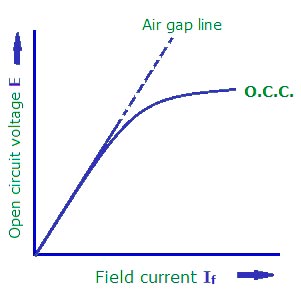No-load saturation characteristics are plotted between
Right Answer is:
No-load voltage and field current
SOLUTION
No-load saturation characteristic of generator: This curve is also called magnetic characteristic or open-circuit characteristic (O.C.C.). It shows the relationship between the e.m.f. generated on no-load in the armature, Eo, and the field current if, with the speed remaining constant. The curve depends on the material used in the electromagnets. It is practically the same, whether the generator is separately-excited or self-excited. Generally, it starts from zero but in a self-excited DC generator, it has residual voltage and starts a slightly higher value.
At the low voltage and, hence, low levels of flux, the major reluctance (magnetic resistance) of the magnetic circuit is the airgap. In the linear portion of the open-circuit curve, terminal voltage and flux are proportional to the field current. This portion of the open-circuit saturation curve, which is linear, is called the “airgap line.”
At higher voltages as the flux increases the stator and rotor iron, saturate, and additional field current is required to drive magnetic flux through the iron. This is due to the apparent higher reluctance of the magnetic circuit. Hence, the upper part of the curve bends away from the airgap line at an exponential or logarithmic rate, dependent on the saturation effect in the stator and rotor. Without the presence of iron in the circuit, the airgap line would continue on linearly, meaning that the terminal voltage and machine flux would increase in linear proportion to the increase in field current.

